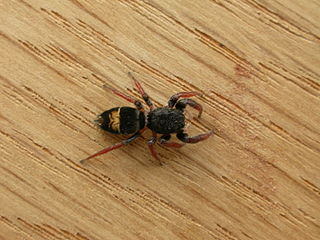
Jumping spiders or the Salticidae are a family of spiders. As of 2019, it contained over 600 described genera and over 6000 described species, making it the largest family of spiders at 13% of all species. Jumping spiders have some of the best vision among arthropods and use it in courtship, hunting, and navigation. Although they normally move unobtrusively and fairly slowly, most species are capable of very agile jumps, notably when hunting, but sometimes in response to sudden threats or crossing long gaps. Both their book lungs and tracheal system are well-developed, and they use both systems. Jumping spiders are generally recognized by their eye pattern. All jumping spiders have four pairs of eyes, with the anterior median pair being particularly large.

Anasaitis is a genus of jumping spiders that was first described by E. B. Bryant in 1950. The name is derived from the salticid genus Saitis.
Compsodecta is a genus of Caribbean jumping spiders that was first described by Eugène Louis Simon in 1903.

Neon is a spider genus of the jumping spider family, Salticidae. Its described species occur mostly in Eurasia, with some species found in North and South America. One species, N. convolutus, is also found in Algeria. Two species are known from Australia, N. australis and N. taylori. N. australis has palp morphology and fringing on its first pair of legs very similar to that seen in N. nojimai Ikeda 1995, from Japan. N. taylori is most similar in morphology to N. sumatranus from Indonesia and N. kovblyuki from the Crimea and elsewhere. The genus is common and widespread in litter throughout Australia, from the highlands of Tasmania through the hot, dry inland to the wet tropics and includes many undescribed species.

Euophryini is a tribe of jumping spiders. It has also been treated as the subfamily Euophryinae.

Servaea vestita is a species of jumping spider from Australia. It is found in Queensland, New South Wales and Tasmania.
Ananeon is a monotypic genus of jumping spiders containing the single species, Ananeon howardensis. It was first described by B. J. Richardson in 2013, and is only found in the Northern Territory.
Barraina is a monotypic genus of jumping spiders containing the single species, Barraina anfracta. It was first described by B. J. Richardson in 2013, and is only found in Queensland.
Chalcolemia is a monotypic genus of jumping spiders containing the single species, Chalcolemia nakanai. It was first described by J. X. Zhang & Wayne Paul Maddison in 2012, and is only found on New Britain.
Chinophrys is a genus of jumping spiders that was first described by J. X. Zhang & Wayne Paul Maddison in 2012.
Corticattus is a genus of Caribbean jumping spiders that was first described by J. X. Zhang & Wayne Paul Maddison in 2012. As of June 2019 it contains only two species, found only on Hispaniola and in Puerto Rico: C. guajataca and C. latus.
Corusca is a genus of Chinese jumping spiders that was first described by Y. Y. Zhou & S. Q. Li in 2013.
Druzia is a monotypic genus of Brazilian jumping spiders containing the single species, Druzia flavostriata. It was first described by G. R. S. Ruiz & Antônio Domingos Brescovit in 2013, and is only found in Brazil.

Ecuadattus is a genus of Ecuadorian jumping spiders that was first described by J. X. Zhang & Wayne Paul Maddison in 2012.
Foliabitus is a genus of Asian jumping spiders that was first described by J. X. Zhang & Wayne Paul Maddison in 2012. As of June 2019 it contains only two species, found only in Asia: F. longzhou and F. scutigerus.
Ancepitilobus is a genus of spiders in the family Salticidae. It was first described in 2016 by Richardson. As of 2017, it contains only one species, Ancepitilobus howensis, found on Lord Howe Island. Its taxonomic relationships within the family are unknown.

Apricia is a genus of spiders in the jumping spider family Salticidae. It was first described in 2016 by Richardson. As of 2017, it contains 3 species, all from Australia.
Capeyorkia is a genus of spiders in the family Salticidae. It was first described in 2016 by Richardson. As of 2017, it contains only one species, Capeyorkia vulpecula, found in Queensland. Its taxonomic relationships within the family are unknown.
Pungalina is a genus of Australian jumping spiders that was first described by Barry J. Richardson in 2013.






